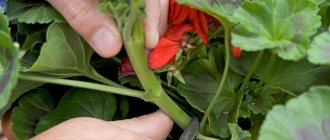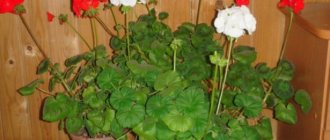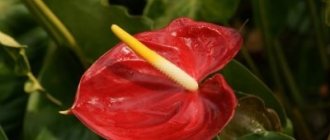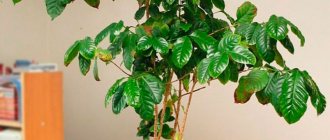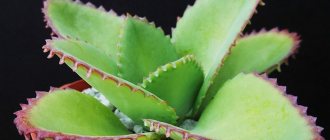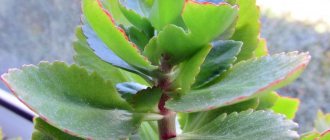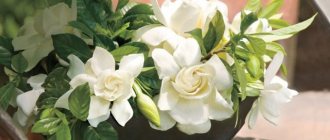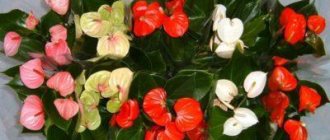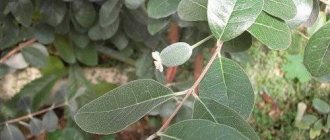Protea is a plant whose belonging to the exotic category can be judged at first glance. A favorite of florists, this outlandish representative of the Proteaceae family can become the highlight of a room or garden collection. The prickly multi-colored heads of huge inflorescences are spectacular, the foliage is original. And even though it is not easy to grow the many-sided protea, and there are not so many options for agricultural technology, even in indoor and greenhouse cultivation it will have time to show all its bright individuality.
The obstinate exotic Protea. © Thierry Leclerc
Exotic with a non-standard appearance and its representatives in garden and indoor culture
Succulents from the Proteaceae family with a non-standard appearance, water-accumulating leaves and underground organs captivate flower growers around the world with their non-standard flowering. The “prickly”, bold-looking heads of inflorescences resemble either artichokes, giant thistles and burdocks, or bottle brushes, but in terms of color and exoticism they will more than give a head start to any other plant. Proteas are far from easy to grow crops, but they will become the most original touch in a collection of plants, and then replenish the collection of the most original dried flowers.
Protea is a genus of plants in the Proteaceae family. The type species of the genus is Protea cynaroides.
Proteas combine hard, oblong-oval (less often linear or needle-shaped) leathery leaves with capitate inflorescences reaching from 5 to 30 cm in diameter. The inflorescences are surrounded by a thick wrapper and are decorated not with small flowers, but with surprisingly unusual bracts. Cone-shaped, with protruding needle-shaped “petals”, they stand out due to their original alternation of colors, unusually different shapes of bracts and sepals, and sweet nectar that attracts honey plants and hides inside the “heads”.
Proteas are not just diverse - they are inimitably multifaceted. It is no coincidence that this culture even received its name in honor of the son of Poseidon Proteus, who is capable of taking on any form. In their homeland, Australia and Africa, where proteas are found literally at every step, these plants can truly boast of extraordinary diversity. In our country, proteas are represented by a much more modest number of species.
Protea artichoke (Protea cynaroides). © Stan Shebs
The main representative of the proteas in our climate is the artichoke protea (Protea cynaroides). Its inflorescences reach 30 cm in diameter. The capitate inflorescences are not only large, but also spectacular. They are made variegated by the original involucres of bracts, painted in different tones. In its homeland, this Protea is known as the “pot of honey”: its nectar is used as a unique remedy for coughs. The white, pink, orange, yellow, and lilac tones of the Protea's colors are sometimes combined in the most variegated variations.
Creeping Protea (Protea repens). © Margret Maria Cordts
Also occasionally found on sale:
- large-headed protea (Protea coronata, formerly known as macrocephala) with bright large heads decorated with arranged peculiar stripes of involucres;
- creeping protea (Protea repens) with recumbent shoots, smaller foliage and smaller “spiny” inflorescence balls.
Protea coronata. © Andrew massyn
Protea - a luxurious flower from Africa
An exotic and rare flower is named after the god of sea waters - Proteus , who changes his appearance. Protea is also called sugar cane or African rose.
Origin
The plant's homeland is located in South Africa, where it is a symbol of South Africa. Protea also grows in Australia, India, and Hawaii, where it is used for wedding bouquets. The nectar of the flower has healing properties and is used as food in its homeland.
Homeland of the plant
Name
Protea is a flower of the Proteaceae family, belonging to the evergreen shrub species. The Africans nicknamed the honey-bearing flower “a pot of honey.”
Protea
Description
Under natural conditions, protea forms a shrub reaching 2 m. When grown indoors, the height of the plant does not exceed 60-70 cm. The bush with long and strong, reddish shoots is covered with dense, leathery leaves. They have an oval-elongated, sometimes linear shape and a dark green color.
Protea blooms with large heads of unusual shape, reaching up to 20-30 cm in diameter when blooming. Needle-shaped petals frame a cone-shaped bowl. The structure and color of bracts and sepals is strikingly diverse.
Appearance
Flowering begins in late spring, when beautiful, large inflorescences bloom on tall peduncles and lasts several weeks. The color of the flowers varies from pink to red in all shades.
There are beige and silver tones. One bush covers several dozen inflorescences, which can be compared to burdock, cones or artichokes.
The Many Faces of Protea
There are over 400 species of representatives of the family. Some resemble marvelous fruits, others resemble stars, and others resemble sea urchins. All of them are brightly colored and striking in their appearance. Cone-shaped inflorescences differ significantly in shape and structure among different species, as well as between representatives of the same species.
Common flower varieties:
- artichoke (Protea cynaroides), which is most widespread due to its large flower up to 30 cm in diameter with bright pink petals. A luxurious flower often used to decorate holidays. Protea cynaroides
- large-headed protea (Protea macrocephala) - a flower as in the photo, with a felt core framed by red, pointed petals. The outer part of the inflorescence consists of smaller scaly petals with a smoky color. Protea macrocephala
- Blackbeard (Protea lepidocarpodendron) with creamy sand flowers. The edge of the inflorescence has a violet, dark purple, brown edge. Protea lepidocarpodendron
- creeping (Protea repens) has recumbent shoots, small foliage and small ball-spines of inflorescences. Protea repens
Conditions of detention
Growing protea requires a lot of effort. A heat-loving flower in a temperate climate grows only in a room and a greenhouse. He will need a place with bright lighting and direct sunlight on the bush for several hours. During the winter months, additional lighting is necessary.
Comfortable conditions for Protea are consistently hot conditions with temperatures ranging from +20°C. In winter, the flower is kept at a cool temperature of 5-10°C. If there is no cool winter, there will be no flowers next year.
Needs bright lighting
The plant needs an influx of fresh air and good ventilation. You can only place the flower on a glazed balcony.
To add decorativeness, the stems of the bush are shortened by 1/4 of their height in the spring. After flowering, the stems are cut to 10 cm.
Watering and fertilizing mode
Between scanty waterings in spring and summer, the soil should have time to dry out, because under natural conditions, protea grows in dry soil. In winter, the breaks are increased and watered once every 3-4 weeks.
Excessive moisture will lead to the death of the plant. Add 2-3 drops of lemon juice or citric acid crystals on the tip of a knife to soft water for irrigation. Protea loves hot air, and humidity can ruin the attractiveness of the inflorescences.
Fertilizing is carried out in order to maintain soil acidity from April to September once a month with fertilizer for azaleas and rhododendrons, mixing half the dosage into the water for irrigation. Proteas are accustomed to poor soils and excess nutrients can destroy them.
Transfer
Young proteas need to be replanted every 2-3 years. At the same time, the size of the container is increased. Choose shallow and wide containers. The top layer is removed from the earthen clod, and the soil around the roots is left untouched. Mature, flowering plants are transplanted only after the pot is filled with roots.
The substrate is prepared loosely, with the addition of expanded clay and soil for acidophilic plants. You can mix equal parts of pine needles, peat, sand with soil for azaleas. An acidic soil pH of 5.0 to 5.5 is recommended.
Protea in a pot
Reproduction
Cuttings will help to quickly propagate potea. Seed propagation is rarely used because flowering occurs only 4-5 years after planting.
Cuttings are cut at the end of summer. A length of 10 cm without flowers is sufficient. They are placed in a damp mixture of peat and sand and left in a lighted place to take root.
Protea in floristry
Florists fell in love with protea for its exotic decorativeness. A bush with glossy leaves is beautiful even without flowers. In a bouquet, protea remains fresh for 2-3 weeks. After drying, it does not lose its color brightness or shape. Dried flowers are used to decorate flower arrangements.
Protea is popular in wedding decor for decorating the hall, arch, and in the bride's bouquet. The flower looks elegant and solemn; it only needs to be supplemented with greenery.
In combination with other flowers, protea will be a leader. It is combined with lush peonies, hydrangea, and majestic roses.
Watch also the video on the topic:
Source: https://RasteniyaDom.ru/sadovye-rasteniya/proteya.html
Use of protea in floriculture
Protea is one of the most original plants for winter bouquets. When dried, the inflorescence heads of the protea retain their shape well and practically do not change color. They can be considered as one of the exotic dried flowers with a long shelf life.
Protea also looks great in living bouquets. Provided frequent changes of water and good lighting, its inflorescences can last longer than any other flowers. Today this plant is recognized as one of the most fashionable for wedding bouquets. The undoubted advantage of Protea is the ability to create compositions intended as gifts for men.
Protea cynaroides - Artichoke Protea
Description Reviews Images
- Protea, “African rose”, is a compact evergreen shrub with stunning bizarrely shaped flowers up to 25 cm in diameter, in nature growing up to 3 m in height, of the Proteaceae family. Protea is native to South Africa. It grows in sandy and rocky areas up to 600 m above sea level.
Protea cynaroides is the national flower of South Africa. The flower size is up to 30 cm in diameter! On the outer side it has many narrow, hard and pointed bracts, or petals. The lower half of the petals are cream or yellow, fading to pink or velvety red on the upper half. Inside there are many white stamens 3-5 cm long, leaning towards the center. The leaves are thick and tough, rounded in appearance. Since the flowers of this species are distinguished by their high nectar content, in places where they are naturally distributed they are called “honey pots.”
In the 19th century, Proteaceae were very popular in Europe: they were grown in the winter gardens of kings and in the homes of the nobility. London merchant Georg Hibbert, whose name was later given to a new genus of Proteaceae from New Zealand, Hibbertia, collected a collection of 150 species of Proteaceae in his garden!
CARE
Lighting. Bright sun with direct rays. Optimal side: south, southeast or southwest. In summer, it is recommended to take it out into the open air, slightly shading it from the scorching sun.
Temperature. In winter, they are kept at a temperature of +8-12ºС. Withstands short-term frosts down to -2ºС.
Watering. Moderate and careful, adding a little citric acid or juice to the water. The soil is kept slightly moist. In winter, during dormancy, watering is limited, but the substrate should not dry out completely.
Humidity. Does not require spraying.
The soil. Poor and acidic, PH 5.5-5.0, suitable soil for Azaleas or Gardenias with the addition of river sand and vermiculite (up to 30%).
Transfer. The container for transplantation should not be deep. Place a thick layer of drainage on the bottom of the container. Transplantation is carried out annually in early spring.
Fertilizers. Protea is not fed; it is especially sensitive to phosphorus. It receives all its nutrients from the soil, which is why it is recommended to replant the plant annually.
Trimming. After flowering, shorten the shoots by 10-12 cm.
Bloom. Protea grown from seeds blooms in the 3rd year of life. Flowering lasts from April to August.
SOWING SEEDS
Soak the seeds for 12 hours in warm water with the addition of stimulants (NV-101, Zircon, Ribav-Extra Epin, etc.). Sow in light, breathable, acidic and moist soil (PH 5.5-5.0), 1 cm deep, and spread the seeds horizontally. Suitable soil for Gardenias or Azaleas with the addition (up to 30%) of inert raising agents: perlite, vermiculite, river sand, etc. The container with the crops is covered with film, small ventilation holes are made and placed on cold stratification for 6-8 weeks at a temperature of +4-5ºС (the bottom shelf of the refrigerator is suitable). Next, the seeds are germinated in the light at a temperature not lower than +23ºС. Keep the soil constantly moist. The first shoots appear from 2 weeks to 3 months after stratification. Seedlings dive in the phase of 3-4 true leaves.
Total
Protea is an evergreen shrub with long shoots and unusually shaped flowers that look like ocean inhabitants. The plant received its name in honor of the sea god Proteus, who was able to change his appearance. Under natural conditions, the shrub grows in southern Africa - it is no coincidence that it is a symbol of South Africa. The flower was first described by the botanist Carl Linnaeus, who noted the various shapes of flowers and leaves.
Protea growing strategy
As a perennial plant, protea can only be grown where there is no frost in winter. In the middle zone, this plant is not grown in open soil, even as a summer plant. The only option is to grow protea in indoor and greenhouse culture. Indoors, subject to cool wintering, Protea can be preserved from year to year. And if it is not possible to arrange a suitable wintering, then in indoor culture protea can be grown as a summer plant, throwing it away after flowering.
The conditions and care parameters required by the plant are the same for proteas growing as a houseplant and for beauties growing in a winter garden.
Protea bush. © porchulacas4ever
Bloom
The main value of the culture is bright, chic flowers. Their diameter can range from five to thirty centimeters. There are varieties with a sickly sweet aroma. Protea is grown in greenhouses and conservatories around the world.
Amazing flowers are used to create original bouquets, including wedding ones. They are able to maintain their freshness for up to twenty days.
Protea can also often be found dried in various compositions. After wilting, you need to trim the stem a few centimeters below the inflorescence. All parts of the flower are non-toxic. But for allergy sufferers, it is better not to keep the plant in the bedroom during the flowering period.
To stimulate flowering, you can supplement the protea with artificial lamps.
Comfortable temperature conditions
Proteas are heat-loving crops. And it is precisely their extreme sensitivity to fluctuations in conditions, the need to grow at consistently hot temperatures that does not allow them to be grown in the soil, even as a summer plant with a short growing season. In the warm season, from spring to mid-autumn, proteas need temperatures from 20 degrees Celsius (within room temperatures or hotter).
The winter regime for keeping protea should provide for a sharp drop in air temperature. Proteas should overwinter in a cool place, at a temperature not lower than 5 degrees Celsius, but not higher than 10 degrees. Without a cool winter, the protea will not bloom again and it is easier to throw away the plant, replacing it with new seedlings.
For Proteas, not only temperature conditions are important, but also good ventilation. This plant cannot grow when the air is stagnant; it needs a constant supply of fresh air and regular ventilation of the room. Protea is not afraid of drafts; the plant cannot be taken out into the fresh air in the middle zone (with the exception of a glazed balcony or loggia, or a glazed patio).
Protea laurifolia. © FarOutFlora
Plant varieties
Currently, more than 400 species of Protea are known. They all differ in the size and shape of flowers and leaves. The most common varieties of shrubs are:
Protea royal or artichoke. Tree-like shrub with thick shoots. The leaves are hard and dense. The flowers are capitate in shape. The shell located on the outside resembles a crown. The petals can be white, lilac or pink. The flower has an original appearance. The inflorescence resembles a honey pot, filled with nectar and attracting insects. Some small birds build nests inside dried flowers. After flowering, the plant ripens with nut-like fruits covered with fine pubescence. Outwardly, they are similar to artichokes, thanks to which this variety got its name.- Protea large-headed. A shrub-shaped plant with thick, durable stems covered with tough bark. The ellipsoid-shaped leaves are colored rich green. The leaf blade is smooth, covered with veins on the outside. During the flowering period, large inflorescences with stipules of bright red-orange color are formed.
- Protea repens. A distinctive feature of this variety are long creeping shoots, abundantly covered with small leaves. The leaves have a slightly elongated shape and are colored bluish-green. The flowers are small, collected in inflorescences. The bracts are formed by pointed yellowish-cherry petals, which from a distance resemble spines. The main condition for keeping this type of protea is acidic sandy or gravel soils, since in the wild it grows on rocky slopes.
- Protea oleandrofolia. This is a very large ornamental bush, characterized by long flowering. The inflorescences are quite large, colored cream, greenish, pink or burgundy. It is very often used to decorate personal plots.
- Protea superb or magnificent. Tall spreading plant. The leaves are elongated, heart-shaped, grayish-green or bluish in color. During the flowering period, the shrub is covered with large round inflorescences formed by flowers of a rich crimson color. Over time, their color changes to pale pink near the base. The variety is resistant to frost down to -5°.
- Protea is exceptional. Under natural conditions, the height of the bush can reach 5 meters. Stems are straight or creeping. The flowers are large, with long petals that look like blades.
Watering and air humidity
Watering can be called the most difficult thing in caring for protea. This plant is extremely sensitive to waterlogging and does not respond well to too much watering. Treatments for Protea should be moderate. It is better to water frequently but sparingly than to overly saturate the soil with moisture. But the drought resistance of Protea, which it exhibits in the soil in regions with warm winters, is almost completely lost in indoor culture. The soil ball for Protea should not be allowed to dry out completely, just allowing the soil to dry out in the top layer and partially in the middle. The winter watering regime cannot be called anything other than meager: Protea at the dormant stage is watered only once a month.
You should also be careful when choosing water for irrigation. For protea, only soft and acidified water is suitable, to which a few drops of lemon juice or citric acid are added on the tip of a knife.
One of the best qualities of the capricious protea is its love of dry air. This plant not only does not need spraying, but any air humidification will not have a very good effect on the attractiveness of the inflorescences. Moreover, Protea loves hot air and is not afraid of being placed next to heating appliances.
Home care
Location
Protea responds well to brightly lit areas. Therefore, you can safely keep it on the windowsill in direct sunlight for several hours a day.
Temperature
The plant loves warmth. Reacts sensitively to sudden changes in microclimatic conditions. In the warm months (from late April to mid-autumn), Proteas need to create an optimal regime. The room temperature should not be lower than +20 degrees.
In autumn, you need to gradually reduce the temperature in the room. In winter, Protea should be kept in cool conditions. The optimal thermometer value for rest is from +5 to +10 degrees. Otherwise, the plant will bloom again and lose its decorative effect. It is almost impossible to restore culture.
In addition to temperature, you also need to provide the flower with access to fresh air. The plant does not develop well when it is stagnant. Unlike most representatives of the flora, it is not afraid of drafts. But in the climatic conditions of the middle zone, the flower can only be placed on a glazed loggia or balcony.
Proper watering
In spring and summer, you need to water the soil regularly. But make sure that between waterings the top layer of the substrate has time to dry completely. In winter, the frequency of watering can be reduced.
Transfer
The container and substrate should be changed once every two years. In this case, the pot should be chosen one size larger than the previous one. On average, an adult plant will need a pot with a diameter of 35 centimeters.
Protea feed
There is no need to apply fertilizers for this crop, with the exception of rare procedures aimed at restoring the acidity of the soil. By adding half the standard dose of fertilizers for rhododendrons or azaleas to the water for irrigation once every 1-1.5 months, you can maintain stable soil characteristics and supplement watering with acidified water. There are other strategies:
- during the active period of development, proteas are fed with a three-fold reduced dose of nitrogen fertilizers or special mixtures for azaleas once a month;
- systemic fertilizing is replaced by applying a full portion of fertilizers in early spring, a month after transplantation, and another fertilizing after the start of flowering.
Proteas will not tolerate excess nutrients: they are accustomed to poor soils and such preferences do not change in a greenhouse or indoor culture.
Protea artichoke (Protea cynaroides). © Patrick G
Types of ruttia for home maintenance and their photos
In total, there are no more than 7 species in this genus, all of them differ in the shades of the inflorescences. Not all are grown as indoor plants, but there are those that can decorate a room, since ruttia is not a picky plant. In addition to keeping it at home in areas with mild climatic conditions, you can grow this shrub even in open ground. The only thing you should pay attention to is during the wintering period; it is necessary for the perennial, but it may simply not survive our harsh winters. But we’ll talk about care a little later, but for now, let’s still look at the photos of which types are popular among indoor plant breeders.
The most popular type of ruttia with yellow flowers, in Russia it is the most common indoor flower. The flowers are formed from a black head at the base and petals with “ears”, as shown in the photo below. This plant is quite easy to grow at home and form it into a neat bush by cutting the cuttings. By the way, this is also done for abundant flowering in the summer. Among other things, yellow ruttium can be grown at home or in open ground as a vine. Some species with yellow flowers may require special support, as ruttia stems are very flexible and can sag. As an ornamental plant for the garden, gardeners often grow pink or white ruttia, which are considered a symbol of tenderness and purity. Most often, such a plant can be seen in flowerpots or on cornices. It is ampelous and will easily complement the interior. But pink and white ruttia are currently very rare plants, their seeds are sold in 2-3 pieces per 1 pack, so you need to be as careful as possible when growing them. There is quite a bit of information on Internet sources about this amazing tropical plant for growing at home, but you can often find photos of ruttia with pink, red and white flowers. Although the most popular species at the moment is Ruttia fruticosa, this indoor perennial has bright orange inflorescences, sometimes with a hint of red.
Transplantation and substrate
Proteas need frequent replanting. Young non-flowering plants are replanted annually, at the classic time. In early spring, change the container for them to a larger one and keep the earthen ball intact, with the exception of the top contaminated layer. Adult flowering proteas should be replanted only when the plant completely fills the earthen ball with roots.
Containers for proteas are chosen in the same way as for most succulents. Shallow and wide pots are more suitable for this culture.
The soil for protea must be chosen very carefully. A plant, accustomed in nature to dry and poor soil, in indoor and greenhouse cultivation should grow in a different substrate than usual. An earth mixture of equal parts of high-moor peat, pine needles and sand or a ready-made substrate for rhododendrons and azaleas is ideal for proteas. The key characteristics of soil are that they are well-drained, have a rough texture, and are acidic (pH 5.0 to 5.5).
Features of growing in a container
Soil mixture composition
To grow protea you will need an acidic substrate. The pH level should be between 5.0 and 5.5. Store-bought substrate designed for azaleas is ideal. The soil should be breathable and rough. At home, the mixture can be prepared from sand, peat, perlite, pine needles, and heather soil.
Top dressing
The plant grows well in poor soils. Therefore, frequent feeding will not be needed. It is enough to periodically increase the acidity of the soil. It is undesirable to use preparations with fluoride. Nitrogen-containing fertilizers are excellent. They need to be divided into 3 applications. Experienced flower growers also recommend preparations made for azaleas for Proteus. The concentration should be halved.
Container options
A small and wide pot is suitable for growing. A layer of drainage should be laid out at the bottom.
Protea reproduction
Obtaining new proteas and growing these plants yourself requires diligence and patience. The thing is that protea seeds (and the beauty can only be propagated with them) are not found on sale very often, and the plant blooms 5-6 years after sowing. If waiting is not for you, look for ready-made protea seedlings.
Seeds are sown in the classic time for summer crops, in March-April. It is better to use a mixture of peat and sand in equal parts as a substrate. They are buried only to a depth equal to twice the diameter of the seeds themselves, and covered with sifted soil on top. It is not worth watering the substrate before the seeds are scattered: after covering them with soil, they need to be very carefully slightly moistened with a spray bottle, covered with glass or film and placed in the Protea’s favorite temperature range from 20 to 25 degrees Celsius. The process of germination is very long: the first shoots will sprout only after 5-6 weeks. The only method to speed up germination is to carry out cold stratification. For this, the seeds can be sown in damp sand and placed for 2 months at a temperature of 7-8 degrees Celsius (the refrigerator is perfect).
It is advisable to remove the cover from the crops immediately after germination. When 2-3 leaves of the protea appear, they need to be transplanted into individual containers. Throughout the entire period of growing for proteas, watering is carried out very carefully, so that drops do not fall on the sprouts themselves, and the substrate is only slightly moist (but does not dry out).
Increasingly, the cutting method is recommended for proteas: stem segments up to 10 cm long are rooted under a hood, provided there is good lighting and planting in a slightly moist peat-sand substrate.
Protea: subtleties of growing a South American shrub
The Protea plant belongs to the large Proteaceae family. There are about 1400 species. In its natural environment it lives in the subtropics and tropics. Homeland - South America. Protea is considered one of the most beloved and beautiful crops. That's why she was chosen as a symbol of South Africa.
It got its name from Carl Linnaeus. It is associated with the ancient Greek sea god Proteus. It has the form of a shrubby evergreen plant. Protea neriifolia and Protea cynaroides are particularly decorative. In the wild, the height of one representative reaches about two meters.
Indoors, the plant does not exceed seventy centimeters.
Reproduction methods
For propagation, apical cuttings are used. On average, their length should be about ten centimeters. For rooting you will need a mixture of perlite and peat. It is important to maintain the temperature from +22 to +24 degrees.
Protea can also be propagated by seeds. But in this case, you need to take into account that the first inflorescences will appear only after five or six years. The seeds need to be sown at the end of winter. To speed up germination, you can use the stratification method - place the seeds in the refrigerator (in a container with wet sand). The temperature should be about +10 degrees.
The next day you need to keep the seeds in water at room temperature. The sowing depth should exceed the size of the bud by two and a half times. To create a greenhouse effect, you need to cover the top of the container with glass.
Germination will occur at temperatures from +22 to +25 degrees. The appearance of the first shoots depends on the quality of the seeds and the conditions created. May take one or several months.
After the formation of the first full-fledged leaves, you need to remove the cover and move the plant to a room with diffused sunlight. It is important to water very carefully. Liquid should not get on the sprouted crop. You can dive after three leaves have formed.
Stimulating flowering
Protea may not form buds for a long time. This is often due to inappropriate care. To create optimal conditions, you will need bright sunlight and warm temperatures. On cloudy days, the plant should be illuminated.
Symbolism
The original interpretation of the African flower is courage and power. There are about 400 varieties of plants with a wide variety of buds, large or small, needle-shaped or more rounded, but the vast majority of the species, in particular the most popular royal protea, visually resemble a crown or a royal scepter. Interesting! The crown teeth are not actually petals.
These are very dense, brightly colored leaves that are resistant to any touch. The name of the flower comes from the name of the ancient Greek god Proteus, famous for his ability to change appearance. The meaning of a wedding flower can be read as a willingness to accept any problems and solve them with honor, staying close to your soulmate, back to back or shoulder to shoulder.
When deciphering the meaning of a floral composition, color is also taken into account:
- white proteas speak of innocence, purity and the beginning of a new life;
- pink - about romantic love, boundless tenderness and caring attitude towards each other;
- red is a symbol of passion, impossible mutual attraction;
- yellow symbolizes well-being on all levels, from material to spiritual happiness and kinship;
- orange proteas mean unbridled joy;
- blue - nobility, especially if you choose a look that looks like a crown;
- purple symbolizes the mystery and creative nature of the bride.
Flower meaning
The name of this unusual plant was given by Carl Linnaeus. Fascinated by the variety of its shapes and colors, he named it “Protea”. The flower, the meaning of whose name the Swedish naturalist connected with the name of the ancient Greek sea god Proteus, who took on different forms and appeared either in the form of strange birds and animals, or in the form of water and fire, amazes with its beauty.
Indeed, even in one copy of this plant you can find leaves of different colors and configurations. Therefore, these exotic representatives of the flora, thanks to their yellow, pink, purple leaves, shaped like fancy bowls and like starfish and urchins, were associated by Linnaeus with the son of Poseidon.
Period of activity and rest
Protea is a flower that requires proper care (transplantation algorithm, description and photo are presented above). The exotic plant remains dormant from late autumn to early spring. Total renewal occurs in mid-March - during this period, Protea appears new shoots and leaves.
If the plant is in deep dormancy, then it cannot be fed. Watering intensity decreases. There is also no need to spray it. The pot with the plant is placed in a cool room.
Mineral fertilizers cannot be used to feed protea.
The soil should not be constantly wet. If there is compressed and dry air in the room, the plant may die - the above-ground parts will dry out. In this case, it needs to be sprayed periodically.
Protea wakes up on its own as the daylight hours lengthen. Watering should be increased gradually. In early spring, the flowerpot is moved to a warm, bright room. You can keep a flower pot on the windowsill for 1.5-2 hours. If Protea does not wake up on time, she is watered with warm water.
Peak activity occurs in late spring and early summer. If the plant is healthy, the flowers ripen quickly enough. The flowering period varies between 15-30 days.
Pests and diseases
This plant is not prone to particular diseases, and can only be affected by late blight (brown rot) fungi, which fungicide chemicals will help to overcome.
Also, African rose often suffers from diseases caused by a lack of chlorophyll. This happens when the wrong water is selected for irrigation.
Also, the possibility of aphids cannot be ruled out, and it is possible to get rid of them by removing them manually. However, a more effective method would be to treat with a drug designed to kill harmful insects - an insecticide.
All the beauty and elegance of the plant cannot be described in a few words just by seeing a photo of the flower. Protea evokes different emotions in every flora lover and admirer. Surely, you will also have an irresistible desire to raise this magnificent creature, delighting everyone around you.
Photo
Large and bright protea buds are the perfect addition to a lush “disheveled” wedding bouquet in boho style or a classic bridal bouquet of roses, and blooming flowers - pale pink, burgundy and even greenish shades - will become a special accent in luxurious floral arrangements . For example, as in the photo:

